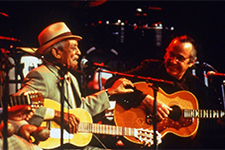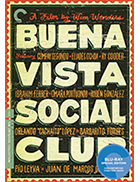Buena Vista Social Club
|  The title of Wim Wenders’s documentary Buena Vista Social Club refers to a Havana social club that that flourished in the 1930s and ’40s and became a significant hang-out for prominent Cuban musicians to mix and mingle and play. Largely forgotten for decades, its name was resurrected in 1997 by Cuban bandleader and folklorist Juan de Marcos González and American guitarist Ry Cooder for an album they recorded of traditional Cuban music played by many of the musicians who had frequented the club at the height of their prominence, but had since sunk into obscurity. Most of the songs and musicians who played them never achieved substantial (or, in some cases, any) recognition outside of their native country, and the combination of González and Cooder’s album and Wenders’s documentary two years later helped expose their artistry to the rest of the world for the first time. It is telling that, early in Wenders’s film, Cooder and Cuban trova guitarist Compay Segundo walk the street of the Havana neighborhood where the club was located, and find that none of the old-timers who still live there and frequented the club can agree on where, exactly, it was located. Like the music and musicians who made the club popular, its memory had been largely wiped out by the ravages of time and inattention, which makes Wenders’s film an absolutely essentially interruption of the potentially tragic historical decay that might have led to its being forgotten forever. The exact physical location where the musicians played may never be agreed upon, but the musicians themselves will be forever present in Wenders’s film, playing the songs that once made them famous and reclaiming a heritage that was on its way to obscurity. Buena Vista Social Club originated with Nick Gold, the head of London’s World Circuit Records, who had initially tasked Cooder with recording the Cuban music by the original players. The film uses a fairly conventional structure, introducing us to more than a dozen Cuban musicians (most of whom were, at the time, in their 70s and 80s, with one almost 90) via a mixture of direct interviews in which they relate their histories and footage of them walking the streets of their neighborhoods and performing in various venues, including Havana’s EGREM studios and a concert in Amsterdam. We learn bits and pieces of their lives and how they fit into the larger history of Cuban music, but Buena Vista Social Club is nothing like a Ken Burns-style documentary that aims to convey large swaths of information. Wenders, who like his New German Cinema contemporary Werner Herzog has slid fluently throughout his career between feature films and documentaries, is content to let the musicians speak for themselves as much or as little as they want to and make their music the film’s centerpiece. In the second half of the film, the musicians travel to New York to perform a series of concerts at Carnegie Hall, which marked the first time Cuban musicians had traveled to and performed in the U.S. in decades (their wonderment at being in the Big Apple is infectious, and their ability to tick off the names of various celebrities like Charles Chaplin in response to bobble-heads they see in a store window is testament to the fluidity of popular culture across various borders). Despite the minimal information we get about them, each of the musicians immediately strikes a unique impression, conveying a tremendous sense of history and culture and artistry. In some ways, Buena Vista Social Club is a frustrating experience because it leaves you wanting to hear so much more, but given the reasonable limits of the feature documentary format, Wenders packs in an impressive amount of experience and, most importantly, secured the place of these amazing musicians in the larger scope of history.
Copyright © 2017 James Kendrick Thoughts? E-mail James Kendrick All images copyright © The Criterion Collection | |||||||||||||||||||||||||||||||
Overall Rating: 

 (3)
(3)


